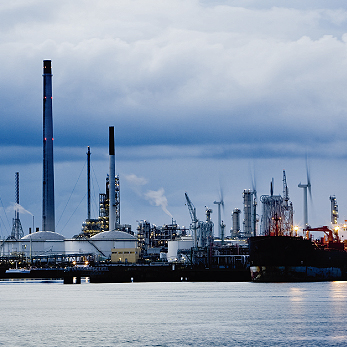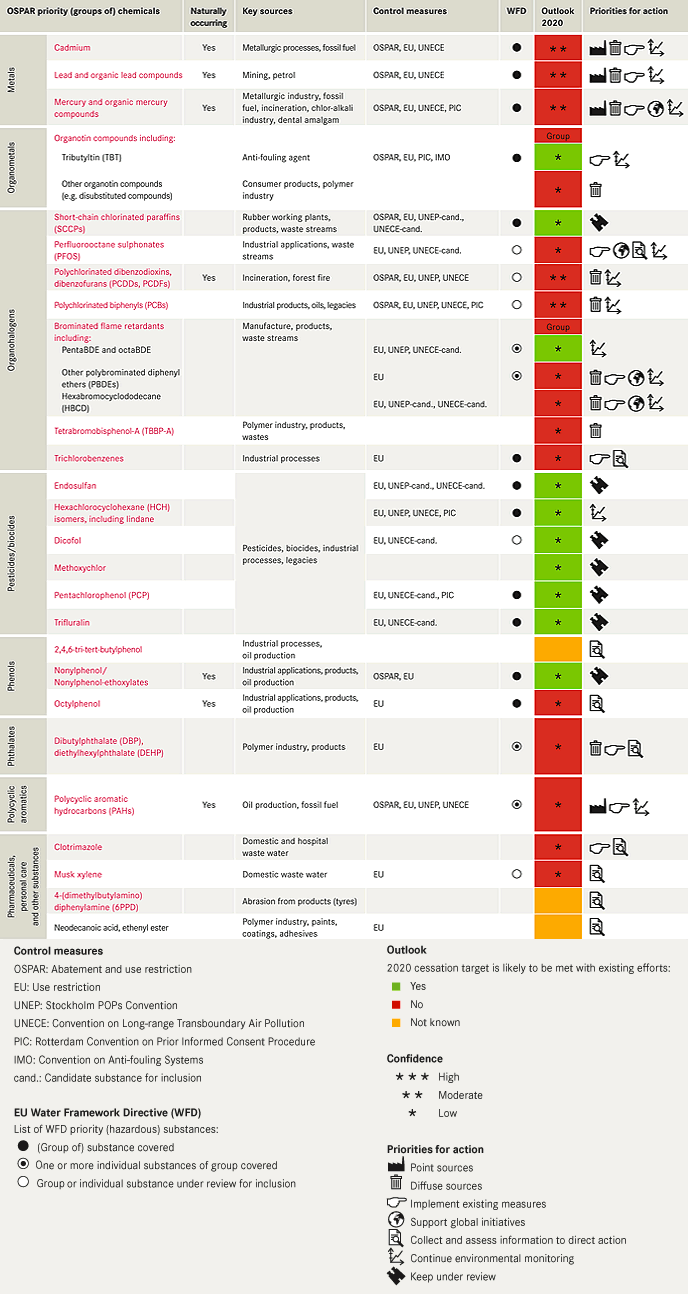More than 30 years of work to control releases
During the 1980s and 1990s, OSPAR adopted more than 60 Recommendations and legally-binding Decisions to regulate the main point sources (e.g. industry) and diffuse sources (e.g. products and wastes) of pollution with hazardous substances in the OSPAR area. OSPAR countries were required to implement best available techniques (BAT) and best environmental practices (BEP) and to achieve specified limit values for emissions and discharges for major industrial sources of heavy metals, organohalogens and polycyclic aromatic hydrocarbons (PAHs). Regulated industries include: large combustion plants; the manufacturing of iron, steel, aluminium, textiles, chlorine, pharmaceuticals, organic chemicals, pulp and paper, and vinyl chloride; and the refining of crude oil. Other measures targeted the uses of particular hazardous substances in industrial processes and consumer products, for example, the phase-out of tributyltin (TBT), PAHs, nonylphenols and short-chain chlorinated paraffins (SCCPs) in main applications. Periodic reporting shows that these measures have been broadly implemented across the OSPAR area. This work has been increasingly supported by implementation of similar EU legislation.
Efforts now focus on specific substances
Since 1998, OSPAR’s work on preventing and reducing pollution has moved from targeting industrial and diffuse sources of pollution to a focus on action for specific hazardous substances. OSPAR has taken a systematic approach to identifying which of the steadily increasing number of substances on the market pose a risk for the marine environment and actively cooperates in this work with non-governmental organisations representing both industry and wider society. OSPAR’s approach takes into account the hazardous properties of the substances both in terms of their persistence, liability to bioaccumulate and toxicity, and properties giving rise to equivalent levels of concern, for example endocrine disruption caused by substances which mimic hormones and interfere with hormone-controlled processes. More than 300 substances are considered to be of possible concern for the marine environment. Forty substances and groups of substances have been identified by OSPAR as chemicals for priority action, of which 26 pose a risk for the marine environment due to their use patterns Table 5.1. OSPAR has undertaken and published a series of assessments of these priority chemicals to evaluate the extent of their risks and to identify priorities for action.
Ongoing collaboration with other international bodies
The EU has covered the field of OSPAR’s work on hazardous substances to an increasing extent over recent years and is now the main driving force for action by OSPAR countries. Its main instrument in this respect is the Integrated Pollution Prevention and Control (IPPC) Directive and the Marketing and Use Directive Table 5.2. As a result, OSPAR’s work has moved towards contributing to and promoting actions within the EU that are complementary to its own objectives. This will ensure that one consistent set of control measures applies in Europe which takes into account concerns for the marine environment. OSPAR has, therefore, given precedence to contributing to the development of BAT under the IPPC Directive over updating its own measures on point sources. Measures that OSPAR has promoted include marketing and use restrictions for mercury (in measuring devices), phthalates (in toys), and most recently the phase-out of the main uses of perfluorooctane sulphonates as water and oil repellents in consumer products such as textiles and carpets, and in fire fighting foams. With similar work taking place under EU chemicals legislation, OSPAR has, since 2004, also paused its systematic work to identify chemicals for priority action. A recent screening of the OSPAR list of substances of possible concern will help OSPAR to focus its efforts on, and raise awareness of, those substances in open use which are presently not covered by EU legislation. The environmental quality standards set for hazardous substances under the EU Water Framework Directive, which concern many OSPAR priority chemicals, are a further driver for regulating pollution sources at river basin level.
OSPAR’s work also supports global action to reduce or eliminate use and emission of priority chemicals that can be transported to the North-East Atlantic by atmospheric or oceanic pathways or be imported into the OSPAR area in products.
Monitoring tracks progress towards OSPAR’s objectives
For each priority chemical, OSPAR has developed a monitoring strategy that sets out the best way to collect data and information on sources, pathways, concentrations and effects, in order to track progress towards OSPAR’s objectives for hazardous substances. This includes long-term data collection under the OSPAR monitoring programmes for atmospheric inputs, riverine inputs and direct discharges, and for the marine environment. These activities provide the basis for coordinated assessments of chemicals in the OSPAR area. However, coverage of priority chemicals by OSPAR monitoring programmes is limited and several chemicals have only recently been included in the Coordinated Environmental Monitoring Programme (CEMP).


